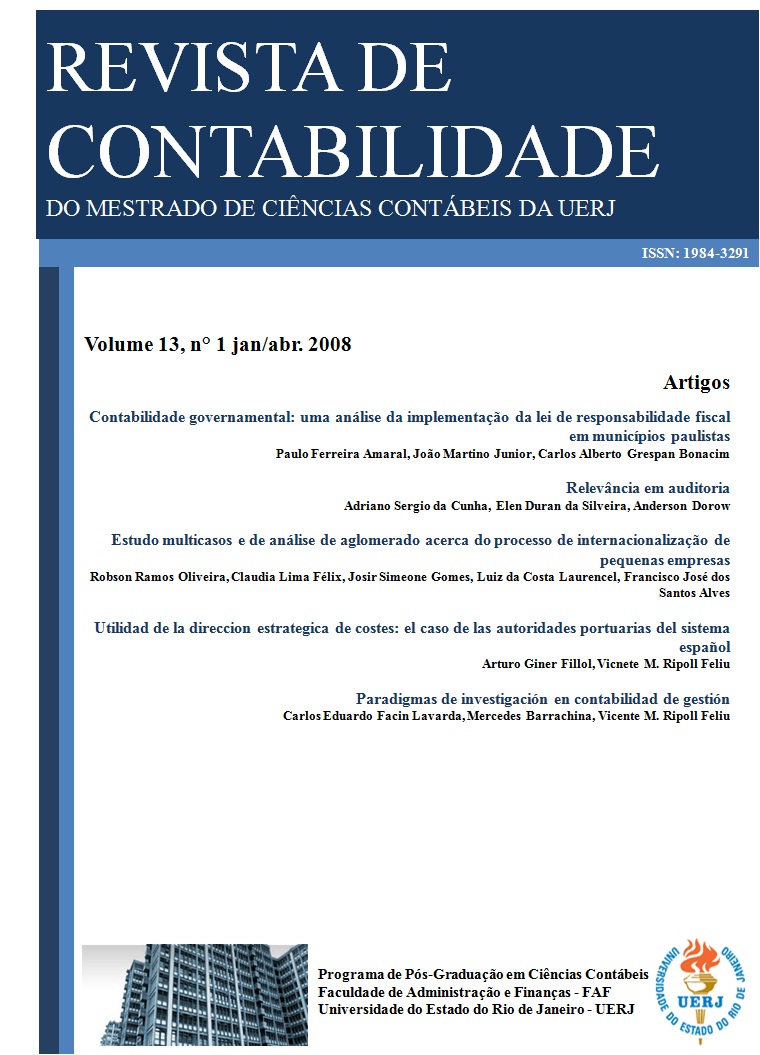CONTABILIDADE GOVERNAMENTAL: UMA ANÁLISE DA IMPLEMENTAÇÃO DA LEI DE RESPONSABILIDADE FISCAL EM MUNICÍPIOS PAULISTAS
DOI:
https://doi.org/10.12979/rcmccuerj.v13i1.5553Resumo
ResumoEste estudo tem como objetivo verificar em que medida nálises comparativas e temporais da estrutura de gastos (custos) do setor governamental podem ajudar a entender como são aplicados os recursos disponibilizados pela sociedade. Inicialmente, verificou-se se os custos governamentais têm relação com o número de habitantes ou com as receitas disponíveis. O primeiro teste aplicado, a todos os 637 municípios paulistas, fazendo-se uma correlação entre despesas de pessoal e número de habitantes. O resultado foi um R-quadrado de 0,84 (sugerindo que 84% das despesas de pessoal se “explicaria” pela população). No conjunto dos municípios analisados, a receita corrente liquida (RCL) cresceu, entre 2001 e 2005, 52,2% acima da inflação medida pelo INPC e a despesa de pessoal 26,6% também em termos reais. Essa
tendência é observada nos cinco anos estudados, e em grande parte explicada pelo aumento da carga tributária total no país. Nesse mesmo período a população desses municípios cresceu 12,9% e o número de funcionários 24,6%. Outro resultado: a proporção de despesas administrativas em relação aos gastos totais variou bastante entre os municípios analisados. O que se conclui é que o gasto público, no Estado de São Paulo, está diretamente vinculado a variação da receita sem correspondência na qualidade do serviço público.
Palavras-Chave: Contabilidade Governamental; Finanças Públicas Municipais; Transparência; Administração Pública; Gastos e Custos com Pessoal
ABSTRACT
This study it has as objective to verify where measured comparative and secular analyses of the structure of expenses (costs) of the governmental sector they can help to understand as the resources trusted for the society are applied. Initially, it was verified if the governmental costs have relation with
the number of inhabitants or available prescriptions. The first applied test, to all the 637 São Paulocities, becoming a correlation between staff expenditures and number of inhabitants. The result was a R-square of 0,84 (suggesting that 84% of the staff expenditures if “would explain” for the
population). In the set of the analyzed cities, the current revenue eliminates (RCL) grew, between 2001 and 2005, 52.2% above of the inflation measured for the INPC and the expenditure of staff 26.6% also in real terms. This trend is observed in the five studied years, and to a large extent explained for the increase of the total tax burden in the country. In this exactly period the population of these cities grew 12.9% and the number of employees 24.6%. Another result: the ratio of administrative expenditures in relation to the
total expenses varied sufficiently between the analyzed cities. What one concludes is that the public expense, in the São Paulo State, directly is tied the variation of the prescription without correspondence in the quality of the public service.
Keywords: Governmental Accounting; Municipal Public Finances; Transparency; Public Administration:
Expenses and Costs with Staff.
Downloads
Publicado
2010-01-27
Como Citar
Amaral, P. F., Junior, J. M., & Grespan Bonacim, C. A. (2010). CONTABILIDADE GOVERNAMENTAL: UMA ANÁLISE DA IMPLEMENTAÇÃO DA LEI DE RESPONSABILIDADE FISCAL EM MUNICÍPIOS PAULISTAS. Revista De Contabilidade Do Mestrado Em Ciências Contábeis Da UERJ, 13(1). https://doi.org/10.12979/rcmccuerj.v13i1.5553
Edição
Seção
Artigos
Licença
Os direitos patrimoniais dos artigos aceitos para publicação, inclusive de tradução, passam a ser de propriedade da Revista de Contabilidade do Mestrado em Ciências Contábeis da UERJ (online).
É permitida a citação parcial de artigos publicados, sem autorização prévia, desde que seja identificada a fonte. A reprodução total de artigos é proibida. Em caso de dúvidas, favor entrar em contato: (revistacontabilidadeuerj@gmail.com).
As declarações dos artigos aprovados, devem ser originalmente assinadas e enviadas por e-mail para o endereço de contato da revista.


